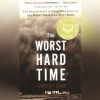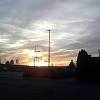Illinois just experienced a very windy day in Montgomery County on Monday, May 1st, that included seven driving related fatalities in the northbound lanes of Interstate 55, between mile markers 76-78, and also another 37 people being hospitalized, and 72 vehicles damaged or destroyed. My prayers go to all involved and their families and friends.
Spring/Summer Weather Series: The Danger of High Winds
There really isn’t a windy season as high winds happen almost year round, for different reasons per season. Spring presents it’s combination of changing weather going all the way from the melting snows of winter into changing from freezing temperatures at the beginning, so with all changes in temperature, winds can present themselves on a dime. Summer and fall present another of their own presentation of winds, and the later summer to complete fall the winds of a hurricane or tropical storm, and any time there is air rushing towards or away from a weather system, depending on if it is a high pressure or low pressure system. and differences in temperature. The windy season is every season, so it is always best to be prepared. So to continue the series of “Spring & Summer Weather Series” the next post here is covering The Danger of High WInds.
༄ 💨 ༄ 💨 ༄ 💨 ༄ 💨 ༄ 💨 ༄ 💨 ༄ 💨 ༄ 💨 ༄ 💨 ༄ 💨 ༄ 💨
BE READY FOR HIGH WINDS NOW!
Does the Forecast Include High Winds?
As informed by the National Weather Service in the article: High Winds Safety Tips and Resources, high winds can be more than just depressing, it can be a downright catastrophe. Also with any high wind event, the winds can lead to a Dust Storm/Haboob or the likelihood of a Wildfire, depending on how dry it is or if there has not been any rain in a long time. Here are the demographics in any case of excessively high winds:
Tips: Preparedness Before, During & After High Winds:
PREPARATION BEFORE THE HIGH WINDS:
Preparation is a very important of the process of making through any high wind event, whether or not it is a period of sustained winds, or just a burst–and being ready. Here are some tips and pointers to assisting you in making sure that you are prepared for winds, way before it shows up on your doorstep:
- Create a Communications Plan! It’s important to be able to communicate with your family and friends if disaster strikes. Having a specific person identified to contact for status updates and having a safe location to meet up with family members is crucial. Have a plan in place if disaster does strike.
- Assemble an Emergency Kit! Assembly of enough food, water and medicine on hand at all times to last at least 3 days in the case of any emergency.
- Water service may become interrupted or unsafe to drink
- Food may not be able to be cooked
- No refrigeration may be available if electric power is interrupted
The Kit:
- Batteries
- Blankets
- Flashlights
- First aid kit
- Rubber boots
- Rubber gloves
- A NOAA Weather Radio or other battery operated radio
- Know Your Risk! Make sure you access whether or not that your home, business or school is in a high risk area for winds. Make sure that you discuss this with your insurance agent before disaster strikes. Make sure that you identify the risks are crucial. Identify an escape plan:
- The roadways
- A Walking path
- The fastest way to get to higher ground
Knowing the answers to these questions ahead of time can mean the difference of saving your life in time of crisis.
- Keep Informed With the Latest Info! Keep informed at the Wind Warnings, Watches and Advisories web-page.
- Prepare Your Home: Sometimes a weather system that includes high winds develop slowly and forecasters can anticipate wind events days or even weeks before they occur. Other times, a beyond just plain windy day can occur within minutes with or without a rain event. Being prepared can save your life and give you peace of mind::
- Making sure that all outdoor patio furniture is tied down, put away or secured.
- Have a professional diagnosis of whether your house is ready for a wind event, including the roofing, siding, gutter, fascia and eaves, windows, doors and a general examination so that once a wind event occurs, that your house is ready as can be
- Being prepared for a power outage.
- Staying away from outer windows.
- Make sure your insurance covers wind damage Ensure coverage on your home and it’s belongings by contacting your insurance agent. This must be done before way before there is an event or a threat of a wind storm. Insurance companies pay attention to zones and once a threat is issued, they stop issuing policies until there is no longer a threat of wind storms, dust storms and the like. Yet even, many insurance policies have provisions that take at least 30 days for benefits to go into effect, so that even if you can buy it as a storm is approaching, it may not have protection, if you do not act before a storm.
- Take photos way before any incident: Take photos for insurance purposes and also so you know what may be lost, should disaster strike. These photos and comparable photos right before you leave will make the claim process a cinch later, if a disaster happens.
- Prepare your Family/Pets: Due to possible evacuation, pack in advance. Don’t procrastinate gathering essentials for yourself, your family and/or your pets.
- Keep your Essential Electronics Charged: Make sure that your cell phone, portable radios, flashlights and other instruments fully charged in case you lose power and/or need to evacuate. Also have back-up batteries for all the above on hand.
- Leave: You don’t have to wait to be ordered to leave; evacuate yourself! Make sure you take another quick set of photos. Try to make sure GPS location set is on while taking , as it helps prove that they were taken before the storm. Make alternative plans for a place to stay. If you have pets, take them with you or make accommodations for boarding them at a friends, family or a facility well away from harm’s way.
- If you can, give blood regularly: Health permitting, make sure you do your part to make sure that the local blood banks are fully restored before a disaster.
DURING THE HIGH WINDS:
If you are present during the arrival of windy conditions, here are some tips and pointers to assisting you in making sure that you are prepared for the conditions of having a high wind event on your doorstep:
- Monitor the speed of wind at all times: The wind speed can quickly change, so remain aware and monitor local radio and television outlets frequently. Avoid the hiogh winds and evacuate immediately if you are contacted by authorities or access danger of staying. Make a decision promptly and don’t wait until it is too late!
- Stay Informed: Listen to radio and television, including NOAA Weather Radio and if possible, check the Internet and social media for the latest information and updates.
- Get to Safe Ground: If you a prone area or are camping in a vulnerable area, get to a safer area immediately. If you notice dangerous speeds of wind, evacuate immediately.
- Obey Evacuation Orders: If you are told to evacuate, please do so immediately. Lock up when you leave. If you have time, disconnect any and all utilities and if possible, appliances.
- Practice Electrical Safety: Do not go into a structure with wired down, or if you see sparking or hear buzzing, crackling, snapping and/or popping noises–get out immediately!
Avoid High Winds: Do not walk through very windy areas unprotected, as projectiles and flying debris can be a presented danger, and if you see a dangerous situation, call 9-1-1 if it is possible. Do NOT drive into an obviously dangerously windy storm, a dust storm, or wildfire, or around a barricade–Turn Around, Don’t Drown! Wind can mask itself to seeing dangerous events, and can hide hazards such as:
- sharp objects
- washed out road surfaces
- electrical wires
- chemicals
- etc.
AFTER HIGH WIND EVENT RECEDES:
When the winds recede, the damage left behind by the wind, all things involved with it and the trauma and elements can be devastating and present many dangers. High wind destruction can depict:
- Destruction to homes and buildings
- Missing, damaged and destroyed possessions
- Missing and destroyed vehicles
However, with the receding wind, decimated possessions, buildings and vehicles can be the toll. Gas leaks and live power lines can be left on and are deadly if not discovered, and are not obvious at first glance, so be very careful!
- Stay Informed: Stay tuned to your local news for updated information on road conditions.
- General Safety: Pay particular attention to the utility companies about restoration and note that the companies often have apps to update you about getting service back. Carbon monoxide poisoning is one of the leading causes of death after a storm that deals with power outages due to the improper use and or placement of a portable generator. Never use a portable generator inside your home, garage or other closed space. For safety information on use of generators, you can review the following: Carbon Monoxide Dangers.
- Avoid Disaster Areas: If you are not trained or a professional, please do not visit disaster areas. Your presence may delay a rescue and other emergency operations that is underway because of concern that you may be injured. It is always the right thing to make sure that this does not happen, because in any emergency situation, time is of essence
- Obey Road Closed and Caution Signs: Road closure and other cautionary signs are not designed to be decorative, and are put in place with safety in mind. Paying attention to them often can mean the difference between life and injury!
- Wait for the “All Clear”: Do not go back to enter your property or searching for items including vehicles until you’re given the “All Clear” by the authorities. If you enter areas with damaged buildings and grounds, be extremely careful. Buildings and grounds can be unstable, so adhere to protocol for safety. Make sure that the electrical system has been disconnected before entry. Have the power company or a qualified electrician fix any wiring. Contact your insurance agent to evaluate property damage. If you have a generator, follow proper safety procedures: FEMA Portable Generators and Winter Storms.
- Contact Your Family and Loved Ones: Let your family and close friends know that you’re okay. Login to Facebook and share your “marked safe” status on either the app or online. Give permission for them to spread the word so you are able to focus on cleaning up the disaster.
- Call your insurance agent: Make an appointment through your insurance agency to have an adjuster dispatched to access the damages. Make sure that you photograph anything you do in an emergency repair situation, so that reimbursement can be accessed after the fact. Anything you do must be documented properly, in order for the adjuster to apply a reimbursement for damages. The agent will be able to give a timetable for getting you back on track and for assisting you in being able to have resources for hiring professionals to repair your property, vehicles or other elements–and get your life back on track again.
Resources:
RESOURCES & RECOVERY AFTER DISASTER: THE HOME & FAMILY + FINANCIAL TOOLKIT:
There are many disaster and emergency preparedness and assistance resources available for you to help you through the hard times rebuilding:
- American Red Cross: redcross.org
- American Red Cross – Contact and Locate Loved Ones: redcross.org/get-help/disaster-relief/contact-and-locate-loved-ones
- American Red Cross – Find an Open Shelter: redcross.org/get-help/disaster-relief-and-recovery/find-an-open-shelter
- American Red Cross – Safe and Well: 1-800-RedCross (1-800-733-2767)
- Apps – American Red Cross: redcross.org/get-help/prepare-for-emergencies/mobile-apps. Separate apps cover the subjects of: blood, earthquake, emergency, first aid, flooding, hero care, hurricanes, pet first aid, tornadoes, and wildfires.
- Pet owner disaster preparation and assistance (ASPCA): aspca.org/pet-care/general-pet-care/aspca-mobile-app. This can assist with personalized missing pet recovery kits, creating digital lost pet flyers that can be shared instantly on the user’s social networks, advice on what to do with your pet before, during and after a storm or natural disaster, and the ability store a pet’s vital medical records and dietary needs, which can shave off precious time in the event of an emergency. This information can be easily stored and shared for your convenience as well.
- DisasterAssistance.gov: disasterassistance.gov provides information on how you might be able to get help from the U.S. Government before, during and after a disaster. If the President makes help available to individuals in your community after a disaster, you can visit this site to apply online.
- Disaster Distress Helpline: disasterdistress.samhsa.gov SAMHSA’s Disaster Distress Helpline provides crisis counseling and support to people experiencing emotional distress related to natural or human-caused disasters and is dedicated to providing year-round immediate crisis counseling for people who are experiencing emotional distress related to any natural or human-caused disaster. This toll-free, multilingual, and confidential crisis support service is available to all residents in the United States and its territories.
- Call: Call 1-800-985-5990 to talk live with a trained crisis counselor. Stress, anxiety, and other depression-like symptoms are common reactions after a disaster.
- Text: “TalkWithUs“ to 66746 to connect with a trained crisis counselor. Stress, anxiety, and other depression-like symptoms are common reactions after a disaster.
- Federal Emergency Management Agency (FEMA): fema.gov FEMA’s mission is to support our citizens and first responders to ensure that as a nation we work together to build, sustain, and improve our capability to prepare for, protect against, respond to, recover from, and mitigate all hazards.
- Military OneSource: militaryonesource.mil Offers various articles and resources for emergency preparedness and natural disasters.
- Money Management in Times of Disaster: personal-finance.extension.org/money-management-in-times-of-disaster with information about Money Management during times of disaster:
- Money management in times of disaster: Preparation
- Returning to your damaged home
- Managing finances and making decisions after a disaster
- Ready.gov: ready.gov Ready is a national public service advertising (PSA) campaign designed to educate and empower Americans to prepare for and respond to emergencies including natural and man-made disasters. The goal of the campaign is to get the public involved and ultimately to increase the level of basic preparedness across the nation. Ready and its Spanish language version Listo ask individuals to do three key things: (1) build an emergency supply kit, (2) make a family emergency plan and (3) be informed about the different types of emergencies that could occur and their appropriate responses.
- Sesame Street (Emergency Toolkits): sesamestreet.org/toolkits/emergencies has simple and easy resources to help you help children and others recover from an emergency.
- The National Terror Alert Response Center: Nationalterroralert.com is a private homeland security blog and not affiliated with any government agency. We archive and comment on homeland security related news items from a variety of news sources and tips, as well as provide immediate updates on breaking stories, bulletins and any change in status to Homeland Security advisory. Nationalterroralert.com has become America’s leading source for homeland security news and information. A collaborative resource of news and analysis related to homeland security events, threats and trends. The National Terror Alert Response Network promotes homeland security emergency preparedness through awareness, education, community involvement and partnerships between individuals, groups and organizations. We strive to chronicle homeland security related news, trends and events in an effort to create national awareness and focus. It is our belief that through education and awareness some instances of terrorism may be prevented and through preparedness lives can be saved.
- TriCare: tricare.mil/disasterinfo In the event of a natural disaster, TriCare US Family Health Plan will post disaster-related information on their homepage. It’s important to know that your TriCare benefits will be maintained during any time of crisis. In the event of evacuation, please take the necessary precautions. In the case of an emergency, dial 911 or go directly to the nearest emergency room. Click on an icon below (on the TriCare website) to read alerts and emergency information in your area.
- TriCare emergency prescription refills: At times during emergencies, TriCare may authorize early refills for prescriptions. You can receive notifications from tricare.mil/disasterinfo if early refills are authorized. TriCare officials remind beneficiaries that early refills are only authorized for beneficiaries who specifically indicate they are impacted by the emergency event.
When disaster strikes, this list helps assist you in getting the help and assistance that you need in order to put your life back together.
High Winds Myths and Facts:
- Myth: You are able to out-drive a wind storm.
Fact: It is not possible to guarantee that any type of driving or attempting to out-drive a wind storm or event would lead to any type of safer ground. Like any type of panic, attempting to out-run a looming wind storm is usually done without though and can lead to sloppy mistakes of facing the elements without a plan. By trying to out-run a wind event only increases chances to and finding trouble before being lead to safety. - Myth: You are able to out-run a the wind.
Fact: It very dangerous ground to be walking around through high winds, with the elements of running into debris, glass, shrapnel, sharp objects. . .leading to injury or death. Desperation and sloppiness. . .and no plan, except scurrying in the uncharted danger of high winds is a gamble worth never getting involved in! - Myth: Point “A” isn’t too far from point “B”, so I am safe.
Fact: Any area in which you cannot actually see or are distracted by weather conditions, could lead to disaster, so care should be exercised! - Myth: We already had a wind event several times, so since the likelihood of another high wind event is low, we are safe.
Fact: High Winds can tend to strike same areas, and sometimes do not follow the same rules! Always be safe and never claim a safe haven area, and do not rationalize or justify the odds of a high wind event “staying away”. - Myth: I live in the big city in a skyscraper, so I am completely safe, because of the architect’s design.
Fact: Even in the middle, it is never completely safe to be in a skyscraper during a windy event. Adhere to protocol and listen to evacuation calls, as It may be an instinct to think “I am several stories above ground so it is not as windy – So I am completely safe from the risk for high winds!” - Myth: There is no rain, so I am completely safe from a wind event.
Fact: High winds don’t need rain to do damage! always adhere to protocol and listen to direction for evacuation, and do what is necessary without delay! - Myth: I live in the mountains, not the valley, so I am safe from any high winds.
Fact: Even a the top of a mountain, wind can be modified, intensified and become dangerous on a dime. Practice safety plans and be prepared. - Myth: The warehouse has a new roof, so it is completely safe from the wind.
Fact: Engineering for roofs, even new ones are not immune for a high wind event. Also if it is too new, it may not have set, so it can become loose easier if the asphalt has not melted properly. Make sure that you are ready for the outcome of a high wind event. Don’t rationalize or reason with a “new” roof being completely safe - Myth: The Sun is out, so I am safe from high winds.
- Fact: Wind is not dependent on any type of cloud cover or lack thereof. Don’t be fooled by the weather conditions being sunny. Be ready because wind can happen anytime, sunny or cloudy.
- Myth: Climate change is affecting winds.
- Fact: The fact is wind has been happening since ancient times. I seen reports of opinions based on climate change, Same areas had different reports, and no scientific facts to back up any report that there is a correlation of climate change effecting the winds. I have seen several referenced articles concerning high winds that have absolutely no citing, and were not written by people in the scientific field, and also by people also writing in the political field on another article. The fact is, you cannot rely on scientific opinions that an area is safe or even dangerous based on climactic changes. All areas are always going to be be subject to the wind–with or without climate change..
High Winds are a nasty fact of life, and happen in conjunction with other phenomenon like hurricanes, thunderstorms–and just by themselves. It is never any fun! Don’t let the next wind event be your last! Pay proper attention and be safe! They are not going away forever, and we need to be prepared, and be safe.

Harrison Haines at Pexels
WIND PREPAREDNESS & RESOURCES
༄ 💨 ༄ 💨 ༄ 💨 ༄ 💨 ༄ 💨 ༄ 💨 ༄ 💨 ༄ 💨 ༄ 💨 ༄ 💨 ༄ 💨
MORE RESOURCES:
Versatileer WEATHER PAGE:![]() Versatileer PREPAREDNESS/COMMONSENSE TIPS & POINTERS:
Versatileer PREPAREDNESS/COMMONSENSE TIPS & POINTERS:
Tropical Activity & Wildfires Report, Tropical Systems-Atlantic & Pacific + wildfire forecasts:
Hurricane Preparedness Kit, courtesy of the Ward Law Group:
FIND YOUR LOCAL NOAA.com WEATHER RADIO STATION:
FIND YOUR LOCAL NATIONAL WEATHER SERVICE FORECAST:
ENERGY USAGE CALCULATOR: Interactive comparison tool courtesy of Energy Use Calculator: energyusecalculator.com
 ENERGY USAGE CALCULATOR: Interactive comparison tool courtesy of saveonenergy.com
ENERGY USAGE CALCULATOR: Interactive comparison tool courtesy of saveonenergy.com
STAY SAFE!!!
Widget not in any sidebars








staying up to date on weather dangers is very important.
Thank you for all these great tips
Excellent tips!
Good info
Great info! Thanks for sharing! Stay safe out there!
This is a lot of good information for everybody. I know I don’t have some of this stuff so I will be correcting that